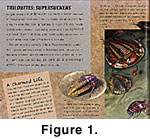Bugs Before Time:
Prehistoric Insects and Their Relatives
by Cathy Camper
Illustrated by Steve Kirk
Simon
& Schuster,
2002, 40 p.
ISBN: 0-689-82092-5. $16.95 |
 |

Cockroaches as big as your shoe! Sea scorpions as
long as a couch! Dragonflies with wingspans almost a yard across! A millipede
about six feet long! These are just a few of the amazing facts presented in Bugs
Before Time: Prehistoric Insects and Their Relatives. This book, while
written for children, will certainly offer even adult readers new, surprising,
and even spine-tingling information about the creepy-crawly history of
arthropods.
Bugs Before Time is full of wonderful
scientific information, including a description of the arthropod class, how to
distinguish insects from other arthropods, how fossils are formed, how
scientists use fossils to decipher information about prehistoric bugs, and how
studying ancient insects has application for life on earth today. For example,
by studying both current and ancient bugs, scientists hope to build robots that
can explore terrains that we humans cannot currently visit, such as the planet
Mars.
One section of the book that I found especially
beneficial was the section dealing with theories of how insect flight evolved.
This portion of the book accurately depicts the process of science:
hypothesizing, theorizing, and experimenting. The world and ancient world are
full of questions without answers; however, those answers may one day be
discovered through the process of science. Therefore, this book could certainly
be an aid to teachers trying to explain the process of science and to encourage
their students to be actively involved in doing science.
While Bugs Before Time certainly has lots
of interesting and valuable information, it also contains a few weaknesses.
There does not seem to be much rhyme or reason to the organization of the book.
For example, the book opens with a discussion of ancient cockroaches, jumps to a
discussion of how fossils are formed, then on to eurypterids (not in the insect
class), back to insect evolution, on to more examples of insects and
non-insects, the theories of insect flight, more bug examples, and finally ends
with a discussion of geologic time. A more logical order and flow of information
would certainly aid in the enjoyment of the book, as well as retention of the
information by developing logical connections between ancient insects, their
relatives, how these ancient creatures are studied, and how they compare to
modern insects and other arthropods.
 Another
possible weakness is the degree of difficulty of some of the content and the
recommended age level of the book (5-9 year olds). The book is fairly lengthy
and will likely be too advanced for most 5 and 6-year olds. The illustrations
are excellent, but by themselves will likely not hold the attention of younger
audiences. However, the layout of the book facilitates enjoyment by a range
of age levels. Arranged in an almost a "scrapbook-style" format, each
page (see Fig. 1) opening highlights
the main text in a gray box, which for the most part is simply written and easily
understandable. For older children or even adults, more advanced information
is available around the central illustration on each opening.
Another
possible weakness is the degree of difficulty of some of the content and the
recommended age level of the book (5-9 year olds). The book is fairly lengthy
and will likely be too advanced for most 5 and 6-year olds. The illustrations
are excellent, but by themselves will likely not hold the attention of younger
audiences. However, the layout of the book facilitates enjoyment by a range
of age levels. Arranged in an almost a "scrapbook-style" format, each
page (see Fig. 1) opening highlights
the main text in a gray box, which for the most part is simply written and easily
understandable. For older children or even adults, more advanced information
is available around the central illustration on each opening.
For her first children’s book, I believe Cathy
Camper has done an excellent job with Bugs Before Time: Prehistoric Insects
and Their Relatives. I would recommend the book for elementary and even
middle school libraries, with a target grade range from second grade to sixth
grade.

